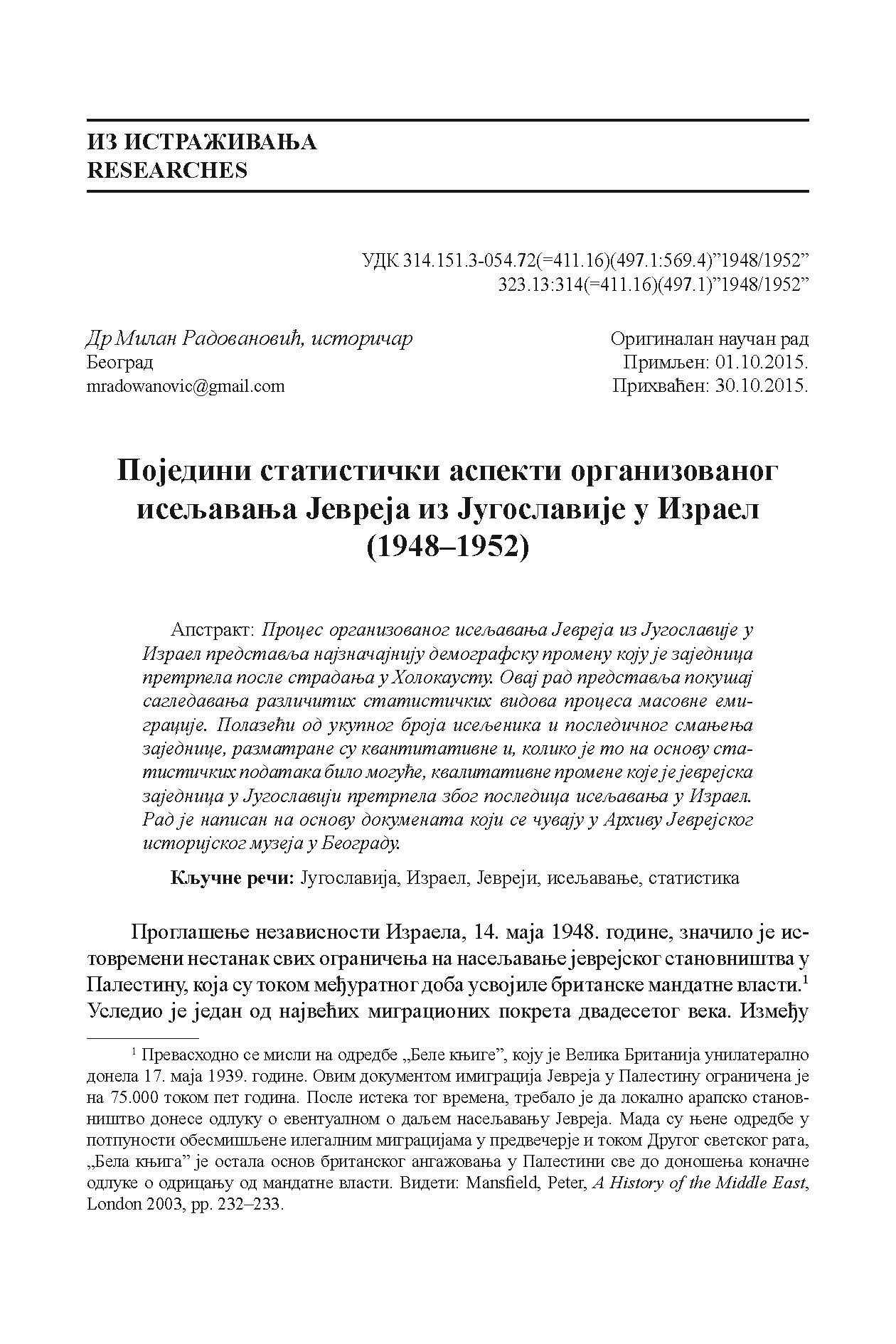Приказ основних података о документу
Pojedini statistički aspekti organizovanog iseljavanja Jevreja iz Jugoslavije u Izrael (1948-1952)
Some statistical aspects of the organized emigration of Yugoslav Jews to Israel (1948-1952)
| dc.creator | Radovanović, Milan | |
| dc.date.accessioned | 2023-10-17T11:51:33Z | |
| dc.date.available | 2023-10-17T11:51:33Z | |
| dc.date.issued | 2015 | |
| dc.identifier.issn | 0354-5318 | |
| dc.identifier.uri | https://www.jevrejskadigitalnabiblioteka.rs/handle/123456789/2561 | |
| dc.description.abstract | Proces organizovanog iseljavanja Jevreja iz Jugoslavije u Izrael predstavlja najznačajniju demografsku promenu koju je zajednica pretrpela posle stradanja u Holokaustu. Ovaj rad predstavlja pokušaj sagledavanja različitih statističkih vidova procesa masovne emigracije. Polazeći od ukupnog broja iseljenika i posledičnog smanjenja zajednice, razmatrane su kvantitativne i, koliko je to na osnovu statističkih podataka bilo moguće, kvalitativne promene koje je jevrejska zajednica u Jugoslaviji pretrpela zbog posledica iseljavanja u Izrael. Rad je napisan na osnovu dokumenata koji se čuvaju u Arhivu Jevrejskog istorijskog muzeja u Beogradu. | sr |
| dc.description.abstract | The organized emigration to Israel was the most significant demographic change, apart from the tragic losses suffered during the Holocaust, afflicting the Jewish community of Yugoslavia. This paper focuses on the diverse statistical aspects of organized emigration, in an attempt to define the primary quantitative and qualitative consequences of this process. The results of our research show that approximately 62% of the Jews living in post-World War Two Yugoslavia left for Israel between 1948 and 1952. Within the migration movement, the Jewish communities of individual Jewish states and cities were represented in accordance with their size. Serbia and the Jewish community of Belgrade were the origin of the better part of migrants leaving the country for Israel, with Croatia (Zagreb) and Bosnia (Sarajevo) following. As the migration movement progressed, the number of participants diminished, and the community left in Yugoslavia was even smaller. This, however, did not lead to later migration waves losing their significance, as the participants still were a significant part of the Yugoslav Jewish community. The internal structure of the migration movement for the most part mirrored that of the Jewish community in post-war Yugoslavia. With respect to citizenship, gender, and age structure, as well as professional orientation the migrants can be considered representative of the Jewish community in Yugoslavia in general, as well as the part that did not move to Israel. | sr |
| dc.language.iso | sr | sr |
| dc.publisher | Beograd : Filozofski fakultet - Katedra za opštu savremenu istoriju | sr |
| dc.rights | openAccess | sr |
| dc.rights.uri | https://creativecommons.org/licenses/by-nc-nd/4.0/ | |
| dc.source | Godišnjak za društvenu istoriju | sr |
| dc.subject | Jugoslavija - Izrael - iseljavanje | sr |
| dc.subject | Jevreji - iseljavanje - statistika | sr |
| dc.subject | Yugoslavia - Israel - emigration | sr |
| dc.subject | Jews - emigration - statistics | sr |
| dc.title | Pojedini statistički aspekti organizovanog iseljavanja Jevreja iz Jugoslavije u Izrael (1948-1952) | sr |
| dc.title | Some statistical aspects of the organized emigration of Yugoslav Jews to Israel (1948-1952) | sr |
| dc.type | article | sr |
| dc.rights.license | BY-NC-ND | sr |
| dc.identifier.fulltext | http://jevrejskadigitalnabiblioteka.rs/bitstream/id/8180/PojediniStatistickiAspektiOrganizovanogIseljavanjaJevrejaOCR.pdf | |
| dc.type.version | publishedVersion | sr |
| dc.citation.spage | 53 | |
| dc.citation.epage | 81 | |
| dc.citation.issue | 2 | |
| dc.citation.volume | 22 | |
| dc.identifier.cobiss | 220894220 | |
| dc.identifier.rcub | https://hdl.handle.net/21.15107/rcub_jdb_2561 |

